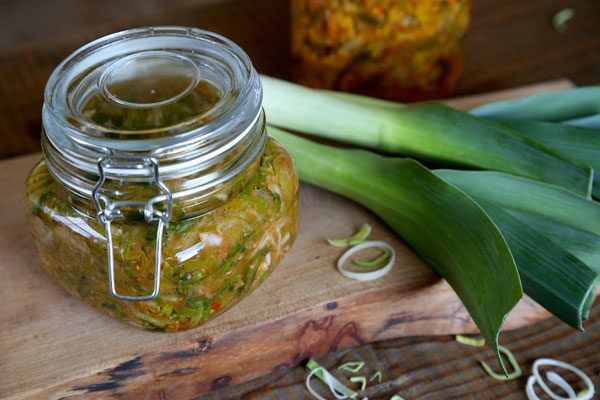
Leekchi
by Aube Giroux on Jan 13, 2016
Leekchi is like kimchi's little cousin, a highly flavorful fermented condiment made simply of leeks, salt, ginger, garlic, and hot peppers. (Recipe Credit: Aube Giroux of Kitchen Vignettes.)
Adapted from Kirsten Shockey and Taproot Magazine (Mend Issue).
- Servings
- Makes about 1 quart
- Course
- Side Dish
Tags
Ingredients
- 6 cups thinly sliced leeks (about 1 ½ pound or 3 large leeks)
- 2 tsp sea salt (pickling or kosher salt is ok but do not use iodized table salt)
- 2 large cloves of garlic (about 1 Tbsp, minced)
- 1 Tbsp finely grated ginger
- 2 tsp hot red pepper powder (ideally Korean kimchi pepper, but a mix of cayenne, paprika, or dried chili flakes is fine - for a really hot leekchi, increase the amount accordingly)
Instructions
-
First, rinse the leeks very well. Soil tends to get stuck in between the layers at the part of the leek where the dark leaves begin to branch out. Also, wash your hands well before starting this recipe because you’ll be using them to mix everything together.
-
Place the thinly sliced leeks (including some of the green tops) into a large bowl. Sprinkle the salt on top. Use your hands to massage the leeks and salt together until the juices begin to release (about 5 minutes). Cover the sliced leeks and allow them to rest for about 45 minutes so the juices continue to release.
-
Add all of your flavoring ingredients: minced garlic, grated ginger, and hot pepper. Mix well until fully incorporated.
-
Press the leek mixture into a clean 2-quart mason jar or crock, or a 1-quart jar if using a clamp-down Fido or Le Parfait jar. In order to ferment vegetables properly, you must keep them submerged under liquid. You’ll want to compress the leeks down to remove all air pockets and to encourage their juices to rise to the top, really packing them down. If you don't have a wooden tamper, you can use the back of your hand or the end of a wooden spoon or rolling pin to press down. If you've pressed the leeks down but there is still not enough liquid to cover them, you can add a bit of homemade brine. Stir 1 tsp salt into 1 cup water until the salt has dissolved. Pour just enough of this brine on top of your leek mixture to cover it.
-
The fermentation process will push the leeks up out of the brine so you may need to weigh them down, depending on the vessel you’re using. If using a mason jar or a crock, top your leeks with a follower and weight combination or use a simple weight made out of a quart-sized ziplock bag. Press the plastic down onto the top of the ferment, then fill it with water and seal. For a jar, screw the lid loosely on top. Do not seal so that gases can escape during the fermenting process. Clamp-on jars such as Fido and LeParfait do not need a weight to keep the vegetables submerged because they can remain closed until the ferment is ready to eat. However, if using this technique, be aware of the small risk that a jar can shatter, as explained in my write-up above. Though this is unlikely, you should wrap any jars in rags or towels and place them in a closed cardboard box in a closet for the active fermentation part, as a safety measure. This article has additional information about how to keep ferments submerged.
-
Leave your leekchi at room temperature, away from direct sunlight for about 1 week. The contents may bubble and seep out so you may want to keep your jars on some newspaper. Unless you are using the clamp-down jar option, you should check your ferment daily to ensure the vegetables are still submerged under brine. Scoop out any scum that develops on the top. Your leekchi is ready when it has turned yellowish, the leeks have softened and developed a nice sour aroma.
-
After about 7 days, the active part of the fermentation should be complete and you can move your jar or crock to the fridge where they will keep for about 6 months.
-
Leekchi is wonderful as a condiment served alongside a warm meal. It’s also lovely with cheese and crackers. You can add it to stir-fry’s, soups, omelettes or scrambled eggs.








